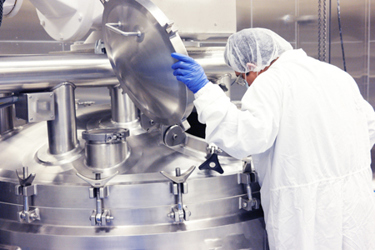How To Measure Cell Density In Real Time With Soft Sensors
By Benjamin Bayer, scientist CMC, Takeda Pharmaceuticals

Soft sensor technology has emerged as a valuable tool in the realm of bioprocessing, revolutionizing the real-time monitoring and control of various critical parameters in biotechnological applications.
The term soft sensor consists of the two terms “software algorithm” and “hardware sensor.” Unspecific hardware sensor signals derived from process analytical technology (PAT) probes are transformed by a software algorithm (e.g., (multi)linear or non-linear regression) into specific concentrations of key process variables. The value of soft sensor technology is that these key process variables may be hard or impossible to measure directly inside the bioreactor (e.g., viable cell density (VCD), product titer, or atypical nutrient levels).
Such bioprocess models provide valuable non-invasive real-time or near-real-time estimations of these key process variables without sampling or subsequent analysis, becoming powerful tools for advanced model-based process monitoring, automation, and control strategies. For example, certain process steps can be executed based on a threshold value instead of a predetermined process time point. Nor are steps limited to relying on a low sampling rate (typically once per day), improving bioprocess traceability, robustness, and reproducibility.
Several PAT probes are available now that offer well-suited options to develop such soft sensors for bioprocesses. Biocapacitance probes have been proven to be perfect candidates to develop VCD soft sensors in upstream bioprocessing because of their measurement principle.
Even though the benefits of utilizing soft sensing in bioprocessing are evident, often, the lack of necessary infrastructure and resources in wet-lab operations prevents the use of these advanced bioprocess solutions.
The Status Quo For Cell Density Monitoring Needs A Makeover
VCD is a key process variable in upstream biologics processes and its real-time measurement is incredibly valuable. The most common procedure to determine the VCD of ongoing culture is daily sampling and at-line analysis.
This procedure inevitably results in a delayed response time for control strategies. Additionally, it limits the data obtained to evaluate time-resolved process performance.
Soft sensing can effectively address this limitation by indirectly measuring the VCD in real time from actual process data without sampling using a preestablished model, i.e., by utilizing a VCD soft sensor, real-time access to this key process variable is granted. Such continuous access to the VCD is crucial for quality by design (QbD) and PAT concepts such as model-based control and automation.
Typically, biocapacitance probes are utilized for developing such a soft sensor to monitor VCD (unit: cells mL-1) in real time. Such probes consist of electrodes that are placed in contact with the culture medium and measure permittivity (unit: pF cm-1) as well as conductivity (unit: mS cm-1).
These electrodes generate an electric field measuring the electrical properties in the bioreactor. The measured permittivity value proportionally increases with the number of living cells, reflecting their cell membrane potential.
Consequently, by utilizing this permittivity signal, the VCD soft sensor is developed, i.e., putting this signal into a linear relation with the VCD measurements. The resulting slope of this regression enables the estimation of the VCD by multiplying the permittivity value with the established model coefficient. Now, continuous real-time estimations of the VCD are enabled due to the high measurement frequency of the biocapacitance probe in the bioreactor (one measurement every 3 to 10 seconds) compared to common daily analytical sampling. Based on this advanced model-based VCD-dependent process, control strategies can be applied.
How We Developed A Globally-Transferrable Soft Sensor
VCD soft sensors are commonly based on the permittivity signal alone and may not be directly applied to new processes, e.g., due to differences in the process setup such as cell line, scale, medium, and biocapacitance probe vendor.
These factors frequently lead to deviations in the correlation between VCD and permittivity, increasing the likelihood of poor model performance. In our experience, their influence can be so great that the development of a universally valid model coefficient utilizing only the permittivity signal cannot be achieved. This results in repeatedly developing new VCD soft sensor model coefficient for each new setup or recalibrating an existing one with new experimental data to enable accurate correlation.
To overcome this challenge, we developed a VCD soft sensor model that shows high performance without the need for recalibration when applied to multiple varying processes. This enables its use as a plug-and-play PAT tool with one agnostic model coefficient. This was made possible by using a coefficient we refer to as the biocapacitance factor, which uses the permittivity and conductivity signal in combination to determine an agnostic model coefficient.
To develop and evaluate our agnostic VCD soft sensor coefficient, we used a large variety of data to ensure its applicability regardless of the production equipment. This includes experiments from different scales (2 L to 2,000 L) and facilities, four operation modes, various programs, and two biocapacitance probe vendors. Significantly enhanced model robustness was seen compared to the state-of-the-art approach utilizing only the permittivity signal. This resulted in a comparable model performance in all processes, regardless of the production equipment and probe vendor used.
Our agnostic VCD soft sensor model now acts as the basis for advanced model-based real-time monitoring, automation, and control strategies in upstream bioprocessing with facilitated transferability. Reliable continuous online monitoring of the VCD increases bioprocess traceability and transparency without recalibrating the coefficient. Based on these estimations, advanced model-based automation and control strategies are set up, i.e., using VCD as a control parameter to execute bioprocess steps based on a VCD threshold value, allowing for precise control over the progression of the process. This can lead to improved reproducibility and overall performance, making it the ideal plug-and-play PAT tool for advanced bioprocessing. Its application areas are versatile, with each offering different advantages, and its explicit advantage with respect to data richness, traceability, and process information is unmatched by common analytical sampling.
In batch and fed-batch operations, automatically executing process steps based on reaching a certain VCD threshold instead of a predefined process timepoint is beneficial for process consistency. This approach leads to fewer deviations and potentially avoids cell starvation as well as subsequent decline in performance. Prominent process steps that benefit from such automated VCD-based decisions are seed train continuation, feed start, and biphasic experiments.
Another example includes controlling the feed flow in perfusion operations. Adjusting the permeate, cell bleed, and media feed via real time cell-specific perfusion rate (rtCSPR) instead of a daily determined CSPR or just exchanging a certain vessel volume per day (VVD) helps prevent issues such as nutrient depletion or accumulation of toxic metabolites. Due to the proportional real-time increase of the feed flow with respect to the VCD a constant supply of fresh medium to the cells and a stable chemical environment are provided. This sustains exponential growth and cell viability with a more efficient process overall. The rtCSPR control strategy will additionally reduce water and raw material consumption, increasing the sustainability of each process.
Such examples of bioprocess steps being executed based on real-time VCD estimations proved to be superior compared to standard operations performed in head-to-head studies. The basis for such advanced bioprocessing steps is the reliable function of the underlying soft sensor model. Our agnostic VCD soft sensor model precisely provides this plug-and-play basis for CHO processes due to its transferability regardless of the production equipment, reducing experimental effort. Among the greatest advantages of utilizing this soft sensor for advanced process control and automation are increased process reproducibility and sustainability, making it a valuable tool in biopharmaceutical processes.
One Hitch — It Works Only During High Viability
The most prominent obstacle we identified is the validity range of the VCD soft sensor model with respect to viability since the required correlation between the biocapacitance signal and VCD measurement is only given at high viability, e.g., in exponential growth phase.
Cells are typically in this state in perfusion processes as well as during early fed-batch days when nutrient supply is sufficient, and waste and byproduct concentrations are low. Once cells enter the stationary phase, their physiology changes (e.g., cell diameter increases) and thereby also the cell membrane potential, decoupling the required correlation between permittivity and VCD. This is a known phenomenon recorded in the literature.
As a result, our developed agnostic VCD soft sensor can be utilized in every process we tested so far, obtaining highly accurate VCD estimations if cell physiology does not drastically change. This enables its application for advanced model-based real-time monitoring, automation, and control in perfusion processes as well as in early fed-batch days for CHO cell cultures. The logical next step for us is to further advance the VCD soft sensor to make it a holistic bioprocess solution, i.e., expanding the viability range in which model estimations are valid by taking multiple frequencies of the biocapacitance probe and multivariate algorithms into account.
Conclusion
Soft sensors are well-suited options for enabling real-time monitoring of key process variables, such as VCD, and applying advanced process control in upstream operations, e.g., VCD-dependent process operations. The real-time availability of these model estimations during the process adds value to bioprocessing by increasing process knowledge, transparency, traceability, reproducibility, and robustness as well as potentially saving resources. However, commonly used permittivity-based VCD soft sensor applications are often limited in their applicability due to the available setup in the specific facilities.
Our work emphasized the development of an agnostic biocapacitance-based VCD soft sensor model, overcoming current limitations with respect to seamless transferability to another site regardless of the scale, program, operation mode, and even biocapacitance probe vendor. Our biocapacitance-based VCD soft sensor model has been applied to a variety of different bioprocesses, achieving highly accurate estimations in these experiments and highlighting its superior universal applicability. We also demonstrated that VCD-based decision-making for executing process steps highly reduces process variability compared to common strategies based on predefined time points. VCD-based perfusion rate control especially proved to be superior with respect to enhanced cell growth and potential resource savings depending on the applied settings when compared to common vessel-volume specific perfusion rate control. These application areas, functionalities, and model properties make it an ideal and highly valuable plug-and-play PAT tool for advanced bioprocessing.
About The Author:
 Benjamin Bayer is a scientist with more than eight years of experience in upstream bioprocess modeling, PAT tools, and data science in academia, the startup sector, and industry. He published several peer-reviewed scientific papers based on his work on these topics and currently focuses on the identification of bottlenecks as well as developing and implementing the right technologies to resolve these, leveraging bioprocess development work. Benjamin received his Ph.D. in bioprocess engineering, specializing in hybrid modeling and quality-by-design implementation in upstream processing. His thesis was recognized with the Award of Excellence, the national award for the best dissertations. Reach him at benjamin.bayer@takeda.com.
Benjamin Bayer is a scientist with more than eight years of experience in upstream bioprocess modeling, PAT tools, and data science in academia, the startup sector, and industry. He published several peer-reviewed scientific papers based on his work on these topics and currently focuses on the identification of bottlenecks as well as developing and implementing the right technologies to resolve these, leveraging bioprocess development work. Benjamin received his Ph.D. in bioprocess engineering, specializing in hybrid modeling and quality-by-design implementation in upstream processing. His thesis was recognized with the Award of Excellence, the national award for the best dissertations. Reach him at benjamin.bayer@takeda.com.
